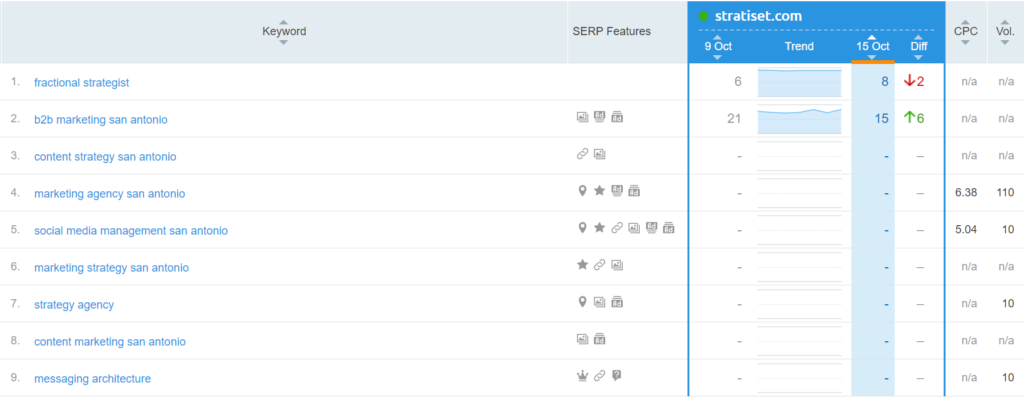A strong brand foundation is essential for digital marketing success. Does keeping content cohesive and on-brand mean limiting topics you can write about? Pounding a handful of the same topics over and over bores audiences and creates SEO issues. Content factoring in SEO, social media, and analytics finds new topic ideas around content pillars. Here’s how we spin up content strategy loops – simple ideas you can use to keep things flowing.
Lay a strong foundation
Content strategy sits on a four-cornered foundation: branding, objectives, positioning, and value drivers. Instantly recognizable branding is important in every piece of content. Brand elements include a logo, color palette, fonts, tag line, image mood, and tone of voice. Good designers create pieces with stopping power within those boundaries. Viral home runs are rare; awareness for most businesses comes through a body of work. When one piece of content breaks through, audiences start realizing there is more to see.
Business objectives should go beyond “we need to generate X leads.” That’s often the first answer given. Dig deeper into the situation. Is this a new business? Opening a new location? Launching a new product or service? Rebranding the business? Where the business sits in its life cycle determines what roles content should play. Objectives drive messaging and media channels aligned with the target audiences.
The lead generation funnel digital marketers talk about is the endgame. Moving into lead generation before establishing awareness is usually ineffective. There are always buying alternatives, some competitive and some internal options. Positioning bridges people from how they see those alternatives to the offering’s unique attributes. Defining positioning is easier when asking three questions about an audience:
- What benefits are they evaluating?
- What do they see as risks?
- What would be a breakthrough?
Those answers point to value drivers. Visitors would cite these as reasons for doing business with a firm, or its competitors. What are best-in-class value drivers across the industry? What differentiator value drivers do the firm offer? You’ll tie each of your key messages back to one or more of these value drivers, ideally with an emotional trigger.
Spend time on the foundation. If you don’t know answers to some of these questions, stop and go get them. Once firmed up, you’ll use it to create, test, and adjust the content strategy.
Establish content pillars
What makes content strategy work is people are already looking for a solution like the one you’re talking about. They may not know about the brand. Often, they begin with no idea why the solution is different. They may not even use the right phrases to look for it. One thing is certain: people will find competitors using familiar terms. You need to build awareness of the brand and its solution, and in the process pull people away from competing ideas and offers.
For this, you’ll need different content targeting awareness, consideration, and decision stages. Jumping straight to the decision stage – asking for a sale – will prove ineffective if people don’t understand who you are or what you stand for. Explain the brand and its positioning first. Later, you can nudge people along the journey with more information.
Start the content strategy loops by heading where the brand should go. Instructors at HubSpot Academy recommend thinking in content pillars with three levels.
- Head term(s), the primary search terms you want alignment with.
- Core topics, phrases extending a head term that can anchor clusters.
- Subtopics, often in the form a natural language question in search.

Source: Content Marketing Institute, https://contentmarketinginstitute.com/2018/04/pillar-content-google/
For example, a head term might be ‘mountain bike’. Core topics would be things like ‘mountain bike pedals’, ‘mountain bike stems’, ‘mountain bike tires’, ‘mountain bike trails near me’, and more. Good subtopics would be ‘what are the best mountain bike pedals’ or ‘how to choose a handlebar stem length’. Core topics and subtopics can grow with the strategy, all reinforcing your head terms.
Next, align core topics and subtopics with key message examples. These are the takeaways for your visitors, tied to one or more value drivers. Good key messages help copywriters create powerful phrasing without restricting creativity. Over time, copywriters gain experience and naturally align new ideas with key messages.
Draw the SEO baseline
Once defined, your head terms won’t change in content strategy loops unless there is a structural change in the business. What can change and expand is core topics and subtopics. Over time, data shows what topics work and where opportunities exist.
For an existing website, start by drawing an SEO baseline, putting what you know into an SEO tracking tool. We prefer SEMrush for SEO analysis for a lot of reasons. Anyone can start with one website (the ‘project’) and 10 keywords to track in a free account, and upgrade from there. Here’s a snapshot of our SEO baseline as we started our strategy exploration.

Notice we selected some core topics with no measurable traffic. That’s OK for an organic content strategy, since these terms are central to our positioning. Also, we extended some terms for local search. For instance, ‘b2b marketing’ has abundant search traffic nationwide. Narrowing it to San Antonio reduces traffic but zooms in on local competitors.
Finding those local competitors is the point. The key to pulling people in is natural-sounding, quality content aligned with your positioning. Identifying the most effective local competitors sets up keyword mining, again an easy task with SEMrush. Some keywords won’t be useful, too specific to their brand, staff, location, or offering. Some keywords point to ideas for cohesive content – core topics and subtopics that you could develop while staying on brand. Add those ideas to your tracking to see how they look.
Write and optimize content
SEO is a big field of study, and it’s intimidating for many people. There are a lot of advanced techniques, and some sketchy ones. There is no substitute for an SEO strategy. You won’t magically win by doing only what we’re discussing. The more competitive the term, the more you need advanced SEO support, either through a consultant or in-house. Yet, there are some things every content team can do to help their cause without being SEO experts.
If content aims at the right audience, SEO struggles usually stem from one of two reasons. Either the content sounds unnatural to human readers, or it doesn’t follow basic SEO guidelines any writer can put in place.
Content should always serve the audience, inviting the reader in with interesting topics and plain language. Complete, grammatically correct sentences are a must. If content sounds unnatural, impressions and ranking suffer. Tactics like keyword stuffing and clickbait titles worsen the problem, always avoid them.
There is no such thing as “writing for SEO.” Data from SEO helps select topics with higher impact. Use that guidance and write what you would write. After writing quality text, there are some simple edits for webpage copy or blogs that give content a chance to succeed. The key phrase for your page should appear in these places:
- Page title
- Meta description
- URL
- <h1> tag – one, and only one, on a page
- First paragraph of text
- At least one <h2> or <h3> subheading
- An image alt tag
- At least four more mentions throughout
Written right, natural-sounding content doesn’t seem optimized. Tools like the Yoast SEO WordPress plugin or the SEMrush SEO Writing Assistant can help check copy optimization. We also use the Hemingway Editor for improved readability.
Many sites have another problem: keyword cannibalization, or more than one page optimized to the same keyword. It’s a myth that more pages targeting the same keyword are better. Without clear signals about which page is most important, you’re leaving it up to Google. More than one page on a keyword splits search energy, and the result is two or more pages that rank lower than they could.
Content pillars suggest a better strategy. Core topic pages should internally link to the head term page, reinforcing it as the authoritative page. Subtopic pages reinforce core topics the same way. Structuring a site in linked clusters leads Google results where they should go.
The path to head term ranking is excellent, optimized content in widening content strategy loops. Cohesive content expands over time, drawing in more people and more ideas while directing energy to the head terms. Great content adds value to the conversation with knowledge worth sharing. Even if new quality content doesn’t get traction right away, it adds to the body of work helping searchers find the site.
Ignite social conversations
Social media management has audience, channels, design, cadence, metrics, and more to think about. The content strategy foundation still applies. Understanding branding, objectives, positioning, and value drivers is essential for social media success. Social media teams often start by developing a social media calendar so they can design and sequence posts across channels.
The superpower of social media is igniting conversations, with a large audience or one-on-one. Here are some of the paths social can take with a calendar.
- Drive long-form content. Fresh blogs or website content get noticed faster when featured in a social post. Shares can amplify content quickly. New content may bridge audiences using hashtags, picking up more people. Parsing a longer piece of content into several ideas for social posts helps more people see it.
- Tap into trending topics. Hashtags and key phrases used by competitors may reveal a core topic or subtopic that’s hot. New product releases or events can spark interest in an idea. Social can also reuse existing content. A slight update or new creative can bring visitors to an existing long-form page.
- Share friendly ideas. The 80-20 rule suggests social should be doing more than promoting content from the brand. There are usually many industry sources with shareable ideas on head terms, core topics, and subtopics. Industry content is powerful in the awareness phase when introducing people to ideas.
Social media results are one of the best indicators for content strategy loops. In a good social strategy, teams often have opportunities for experimenting with new core topics and subtopics. If conversations don’t happen, the investment is less than developing full-length content. Positive response to content shows what audiences are looking for in real-time.
Analyze what happens
One of the biggest content fallacies is every piece of content must convert immediately or it’s a failure. This belief stems from impatience. It’s demoralizing for content teams working hard on quality, aiming at different audience segments and journey stages.
Here’s the good news. We’ve seen many situations where suddenly, after several pieces of content fell flat, one new piece tips the scale. Why does that happen? It’s a question of what you’re measuring – the key performance indicators, or KPIs.
A basic analytics suite is easy to set up. It should include Google Analytics, Google Search Console, an SEO tracking tool such as SEMrush, and social media tools including Facebook Insights and Twitter Analytics. Avoid the “charts and graphs” approach. It’s easy to toss information from analytics that says little to nothing about KPI alignment. For instance, ranking on an obscure term unrelated to your content pillar isn’t a win. Look for data on the right KPIs.
In early content strategy loops, you’re looking for two trends: awareness and interest measured by impressions or reach. Impressions should be growing, but not just any impressions. You want phrases tracked in your SEO tool to start aligning with phrases appearing in Google Search Console queries. If they are, you’re on the right trajectory.
Discover intent and repeat
You’ve been around the content strategy loop once. You laid the foundation, set up content pillars, wrote stuff, shared it on social, and saw some results. Now what? It’s time to discover how well your content shapes visitor intent.
Without data from a trip around the loop, it’s hard to determine if you’ve matched intent or not. We can only create content based on what we know at a given time. Evaluating intent means digging a bit deeper into the page, looking at qualitative factors in visitor experience.
- Does the page draw impressions from terms in your strategy?
- Does it talk about what the visitor expected when they clicked in?
- How are visitors consuming the page – what does a heatmap show?
- Is the call to action (CTA) effective in conversions – would you click it?
Time on page and bounce rates are interesting metrics but can be deceiving. In Google Analytics, if a visitor enters, views a page, and leaves without viewing another page, the time on page for that visit scores as zero. The visit also scores as a bounce, making it seem like the visitor left in a hurry. For a landing page, that’s bad.
Perhaps this page in question is a blog post, and the visitor spent five minutes reading it. Zero time and a bounce in GA. If that visitor returns later with that information, then acts, was that post successful? How much content does someone need to see before acting?
If they still have a question, it might be one more piece. That’s why there is often a lag between sharing content and getting results. Intent helps determine your next priority. Your resources may be better spent revising an existing page that’s not answering the right questions. Or, writing new content on a subtopic indicated by social conversations may be most effective.
Intent enables conversion, after positioning and awareness are in place. Each trip around the loop tells you more, qualitatively and quantitatively, about how you’re shaping intent.
Content strategy isn’t poured in concrete. New content strategy loops may target competitive terms, address a conversation on social, or introduce a new idea that visitors haven’t learned much about yet. The sum of expanding efforts is what wins. Keep content flowing, focusing on quality and alignment with your audience and business objectives, and you’ll see progress.

